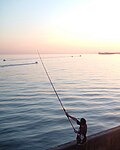Difference between revisions of "AY Honors/Island Fishing/Answer Key"
JadeDragon (talk | contribs) |
JadeDragon (talk | contribs) |
||
| Line 30: | Line 30: | ||
==6. a. Collect pictures of ten tropical fish and identify their local names and their habitation. == | ==6. a. Collect pictures of ten tropical fish and identify their local names and their habitation. == | ||
| + | |||
| + | Ten tropical fish photos is not very many. You COULD collect the photos off the internet in a few minutes but it will be more fun to go catch the ten types of fish and photograph them. If you do not live in a tropical area you could visit an aquarium or even a large pet store and photograph ten tropical fish types. Display your collection on poster board or electronically in a blog post or powerpoint presentation. | ||
| + | |||
| + | While you are on the topic of fish, look at the Fish Honor in the Nature chapter. | ||
| + | |||
==6. b. Name ten poisonous or dangerous fish in your area.== | ==6. b. Name ten poisonous or dangerous fish in your area.== | ||
Revision as of 19:50, 15 April 2014
1. Name five native methods that are used for island fishing.
- Angling
- Angling is a method of fishing by means of an "angle" (hook). The hook is usually attached by a line to a fishing rod. A bite indicator such as a float is sometimes used.
- Nets
- A fishing net or fishnet is a net that is used for fishing. Fishing nets are meshes usually formed by knotting a relatively thin thread. Modern nets are usually made of artificial polyamides like nylon, although nets of organic polyamides such as wool or silk thread were common until recently and are still used.
- Trapping
- A typical trap might consist of a frame of thick steel wire in the shape of a heart, with chicken wire stretched around it. The mesh wraps around the frame and then tapers into the inside of the trap. When a fish swims inside through this opening, it cannot get out, as the chicken wire opening bends back into its original narrowness. In earlier times, traps were constructed of wood and fibre.
- Spearfishing
- Spearfishing is an ancient method of fishing that has been used throughout the world for millennia. Early civilizations were familiar with the custom of spearing fish from rivers and streams using sharpened sticks.
- Poison
- Though not an environmentally sound practice, some island cultures would gather roots known to be toxic to fish, grind them up, and dump them into a river. The fish would be paralyzed (or killed) and float to the surface where great numbers of them could be gathered. This method is not sustainable.
2. Demonstrate your ability to make at least one type of fishing gear out of native material used in your area.
The simplistic traditional fishing gear is make is going to be a spear, just a sharpened stick. The sharper the better.
Traps and nets are going to be more impressive and fun options to build. Research what kind of fishing gear is used in your area and how it is made before starting your project.
3. In your cultural setting identify types of fishing according to tides and phases of the moon.
4. Display and label a collection of baits, lures and hooks traditionally used in your area.
While this requirement is vague, in this case your collection should include items you will actually use to complete the practical parts of the Honor. Enjoy learning about and collecting the fishing gear used. Note you do not need to BUY everything to display and label, you may be able to make or borrow some items. Traditional fishing gear is usually fairly easy to make since it is not mass produced but home grown.
5. Participate in a fishing trip and catch two fish using two different traditional methods.
Happy fishing, good luck.
6. a. Collect pictures of ten tropical fish and identify their local names and their habitation.
Ten tropical fish photos is not very many. You COULD collect the photos off the internet in a few minutes but it will be more fun to go catch the ten types of fish and photograph them. If you do not live in a tropical area you could visit an aquarium or even a large pet store and photograph ten tropical fish types. Display your collection on poster board or electronically in a blog post or powerpoint presentation.
While you are on the topic of fish, look at the Fish Honor in the Nature chapter.
6. b. Name ten poisonous or dangerous fish in your area.
This is going to require research locally and can not be answered generically in this guide.




